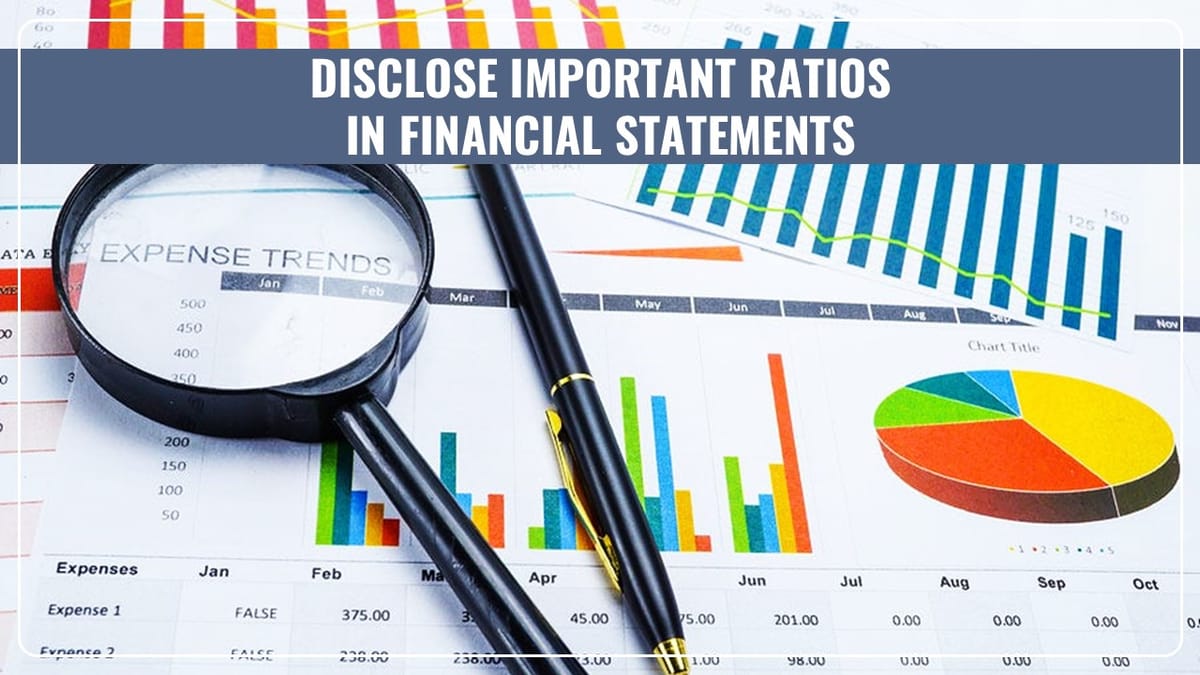Reetu | Aug 28, 2024 |

Important Ratios to be disclosed in Financial Statements as per Company Law
Accounting ratios are comparisons of two or more financial data used to analyze a company’s financial accounts. It is an effective tool for shareholders, creditors, and other stakeholders to understand a company’s profitability, strength, and financial health. This is also known as financial ratios, which are used to assess corporate performance and make key business choices.
All of these ratios are used to assess business performance and compare results to competitors. These ratios are to be disclosed in Financial Statements as per Company Law.
Let’s discuss each of the ratios in detail below.
= Current Assets/ Current Liabilities
For this ratio, 2:1 is considered as ideal.
The current ratio is a regularly used liquidity measure that compares a company’s current assets to its current liabilities. This ratio is used to determine if the company will be able to pay its debts due in the next 12 months.
= Debt Capital/ Shareholders Equity
This ratio is earning before Interest, Tax and Amortization. For this ratio, 2:1 is considered as ideal.
Business with heavy Debt-equity ratio shows that it is more dependent on debt to operate. This is also known as the Gearing ratio, and it is used by investors and creditors to assess the company’s financial leverage.
= EBITA/ Total Debt Service
Debt Service is [Principal + Interest]. For this ratio, 1:25 is often considered as ideal. However, the ratio depends on the Industry.
The debt-service coverage ratio (DSCR) calculates a company’s available cash flow to meet its present debt obligations. The DSCR informs investors and lenders whether a company has enough income to cover its debts. The ratio is derived by dividing net operational income by debt service, which includes both principal and interest.
= PAT/ Average Shareholder Equity
The ratio is when the higher is the better. This should be Profit after Tax.
Return on equity (ROE) measures a company’s financial performance. It is computed by dividing net income by shareholder equity. Because shareholders’ equity equals a company’s assets less its debt, ROE is a measure of a company’s net asset return.
= COGS/ Average Inventory
*Cost of Goods Sold (COGS) = Opening Stock+ Purchases – Closing Stock
Inventory turnover is the rate at which inventory items are sold, used, and replaced. The inventory turnover ratio is computed by dividing the cost of items by the average inventory throughout the same period. A larger ratio often indicates robust sales, whereas a lower ratio indicates weak sales.
= Net Sales/ Avg Receivables
It is calculated by dividing net credit sales by the average accounts receivable over a specified time period. The Trade Receivables Turnover Ratio (or Accounts Turnover Ratio) evaluates how frequently a company turns its accounts receivable into cash over a certain time period.
= Net Purchases and Direct Expanse/ Aug Payable
Trade Payables Turnover Ratio is sometimes called Accounts Payable Turnover Ratio or Creditors Turnover Ratio. This ratio is used to calculate how many times a business pays off its creditors or suppliers in a given accounting period.
= Sales/ Working Capital
*Working Capital = Current Assets – Current Liabilities
The capital turnover ratio measures a company’s operating efficiency based on how it allocates equity capital.
= Net Profit or PAT/ Total Revenue
The ratio is when the higher is the better.
Net profit ratio, often known as net profit margin, is a measure of a company’s after-tax financial performance or profitability. It helps to compare the company’s profit to the overall amount of money invested in the firm.
= Earnings before Int and Tax/ Capital Employed
*Capital Employed = Shareholders Equity + Long Term Debt
The ratio is when the higher is the better.
Return on Capital Employed (ROCE) is a financial ratio that measures a company’s profitability and capital efficiency. In other words, this ratio can help you understand how well a company uses its capital to generate profits.
= Income generated from Investment/ Investments
Return on investment (ROI) is a performance metric used to assess the efficiency of a single investment or to compare the efficiency of multiple investments.
In case of any Doubt regarding Membership you can mail us at [email protected]
Join Studycafe's WhatsApp Group or Telegram Channel for Latest Updates on Government Job, Sarkari Naukri, Private Jobs, Income Tax, GST, Companies Act, Judgements and CA, CS, ICWA, and MUCH MORE!"